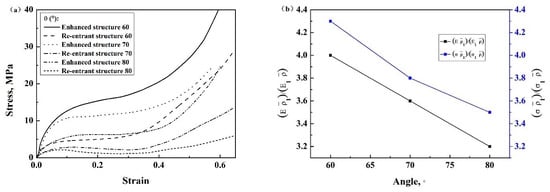An Enhanced Three-Dimensional Auxetic Lattice Structure with Improved Property
Abstract
1. Introduction
2. Experimental
2.1. Structure Design
2.2. Fabrication of Lattice Samples
2.3. Mechanical Measurement
3. Results and Discussion
3.1. Parameter Studies of the Structures
3.1.1. Effect of Strut Diameter d
3.1.2. Effect of θ Angle
3.2. Effect of Compression Direction
3.3. Effect of Material
3.4. Analysis of Enhanced Mechanical Properties
4. Conclusions
Author Contributions
Funding
Conflicts of Interest
References
- Salit, V.; Weller, T. On the feasibility of introducing auxetic behavior into thin-walled structures. Acta Mater. 2009, 57, 125–135. [Google Scholar] [CrossRef]
- Evans, K.E.; Alderson, A. Auxetic materials: Functional materials and structures from lateral thinking! Adv. Mater. 2000, 12, 617–628. [Google Scholar] [CrossRef]
- Lakes, R. Foam structures with a negative Poisson’s ratio. Science 1987, 235, 1038–1041. [Google Scholar] [CrossRef] [PubMed]
- Lakes, R.; Elms, K. Indentability of conventional and negative Poisson’s ratio foams. Compos. Mater. 1993, 27, 1193. [Google Scholar] [CrossRef]
- Scarpa, F.; Yates, J.R.; Ciffo, L.G.; Patsias, S. Dynamic crushing of auxetic open-cell polyurethane foam. J. Mech. Eng. Sci. 2002, 216, 1153–1156. [Google Scholar] [CrossRef]
- Howell, B.; Prendergast, P.; Hansen, L. Examination of acoustic behavior of negative Poisson’s ratio materials. Appl. Acoust. 1996, 43, 141. [Google Scholar] [CrossRef]
- Scarpa, F.; Smith, C. Passive and MR fluid-coated auxetic PU foam–mechanical, acoustic, and electromagnetic properties. J. Intell. Mater. Syst. Struct. 2004, 15, 971. [Google Scholar] [CrossRef]
- Scarpa, F.; Bullough, W.; Lumley, P. Trends in acoustic properties of iron particle seeded auxetic polyurethane foam. Proc. Inst. Mech. Eng. Part. C J. Mech. Eng. Sci. 2004, 218, 241. [Google Scholar] [CrossRef]
- Doyoyo, J.W. Plastic failure analysis of an auxetic foam or inverted strut lattice under longitudinal and shear loads. J. Mech. Phys. Solids 2006, 54, 1479–1492. [Google Scholar] [CrossRef]
- Kuribayashi, K.; Tsuchiya, K.; You, Z.; Tomus, D.; Umemoto, M.; Ito, T.; Sasaki, M. Self-deployable origami stent grafts as a biomedical application of Ni-rich TiNi shape memory alloy foil. Mat. Sci. Eng. A. 2006, 419, 131–137. [Google Scholar] [CrossRef]
- Ali, M.N.; Rehman, I.U. An Auxetic structure conFigured as oesophageal stent with potential to be used for palliative treatment of oesophageal cancer; development and in vitro mechanical analysis. J. Mater. Sci. Mater. Med. 2011, 22, 2573–2581. [Google Scholar] [CrossRef] [PubMed]
- Ko, J.; Bhullar, S.; Cho, Y.; Lee, P.C.; Jun, M.B.G. Design and fabrication of auxetic stretchable force sensor for hand rehabilitation. Smart Mater. Struct. 2015, 24, 075027. [Google Scholar] [CrossRef]
- Gibson, L.J.; Ashby, M.F.; Schajer, G.S.; Robertson, C.I. The mechanics of two-dimensional cellular materials. R. Soc. 1982, 382, 25–42. [Google Scholar]
- Caddock, B.D.; Evans, K.E. Microporous materials with negative Poisson’s ratios. I. Microstructure and mechanical properties. J Appl Phys 1989, 22, 1877. [Google Scholar] [CrossRef]
- Prall, D.; Lakes, R.S. Properties of a chiral honeycomb with a Poisson’s ratio of—1. Int. J. Mech. Sci. 1997, 39, 305–314. [Google Scholar] [CrossRef]
- Yang, L.; Harrysson, O.; West, H.; Cormier, D. Compressive properties of Ti–6Al–4V auxetic mesh structures made by electron beam melting. Acta Mater. 2012, 60, 3370–3379. [Google Scholar] [CrossRef]
- Lira, C.; Scarpa, F. Transverse shear stiffness of thickness gradient honeycombs. Compos. Sci. Technol. 2010, 70, 930–936. [Google Scholar] [CrossRef]
- Hou, Y.; Neville, R.; Scarpa, F. Graded conventional-auxetic Kirigami sandwich structures: Flatwise compression and edgewise loading. Compos. Part B-Eng. 2014, 59, 33–42. [Google Scholar] [CrossRef]
- Boldrin, L.; Hummel, S.; Scarpa, F. Dynamic behaviour of auxetic gradient composite hexagonal honeycombs. Compos. Struct. 2016, 149, 114–124. [Google Scholar] [CrossRef]
- Assidi, M.; Ganghoffer, J.F. Composites with auxetic inclusions showing both an auxetic behavior and enhancement of their mechanical properties. Compos. Struct. 2012, 94, 2373–2382. [Google Scholar] [CrossRef]
- Lu, Z.X.; Li, X.; Yang, Z.Y. Novel structure with negative Poisson’s ratio and enhanced Young’s modulus. Compos. Struct. 2016, 138, 243–252. [Google Scholar] [CrossRef]
- Fu, M.H.; Chen, Y.; Hu, L.L. A novel auxetic honeycomb with enhanced in-plane stiffness and buckling strength. Compos. Struct. 2017, 160, 574–585. [Google Scholar] [CrossRef]
- Huang, Y.J.; Xue, Y.Y.; Wang, X.F. Mechanical behavior of three-dimensional pyramidal aluminum lattice materials. Mat. Sci. Eng. A 2017, 696, 520–528. [Google Scholar] [CrossRef]
- McKown, S.; Shen, Y.; Brookes, W.K.; Sutcliffe, C.J.; Cantwell, W.J.; Langdon, G.S.; Nurick, G.G.; Theobald, M.D. The quasi-static and blast loading response of lattice structures. Int. J. Impact. Eng. 2008, 35, 795–810. [Google Scholar] [CrossRef]
- Gumruk, R.; Mines, R.A.W.; Karadeniz, S. Static mechanical behaviours of stainless steel micro-lattice structures under different loading conditions. Mater. Sci. Eng. A 2013, 586, 392–406. [Google Scholar] [CrossRef]
- Fu, M.H.; Chen, Y.; Hu, L.L. Bilinear elastic characteristic of enhanced auxetic honeycombs. Compos. Struct. 2017, 175, 101–110. [Google Scholar] [CrossRef]
- Schäffler, P.; Hanko, G.; Mitterer, H. Alulight Metal Foam Products. Proc. Porous Metals Metallic Foams Metfoam 2018, 7–10. [Google Scholar]
- Andrews, E.; Sanders, W.; Gibson, L.J. Compressive and tensile behaviour of aluminum foams. Mater. Sci. Eng. A-Struct. 1999, 270, 113–124. [Google Scholar] [CrossRef]
- Ruan, D.; Lu, G.; Chen, F.L.; Siores, E. Compressive behaviour of aluminium foams at low and medium strain rates. Compos. Struct. 2002, 57, 331–336. [Google Scholar] [CrossRef]
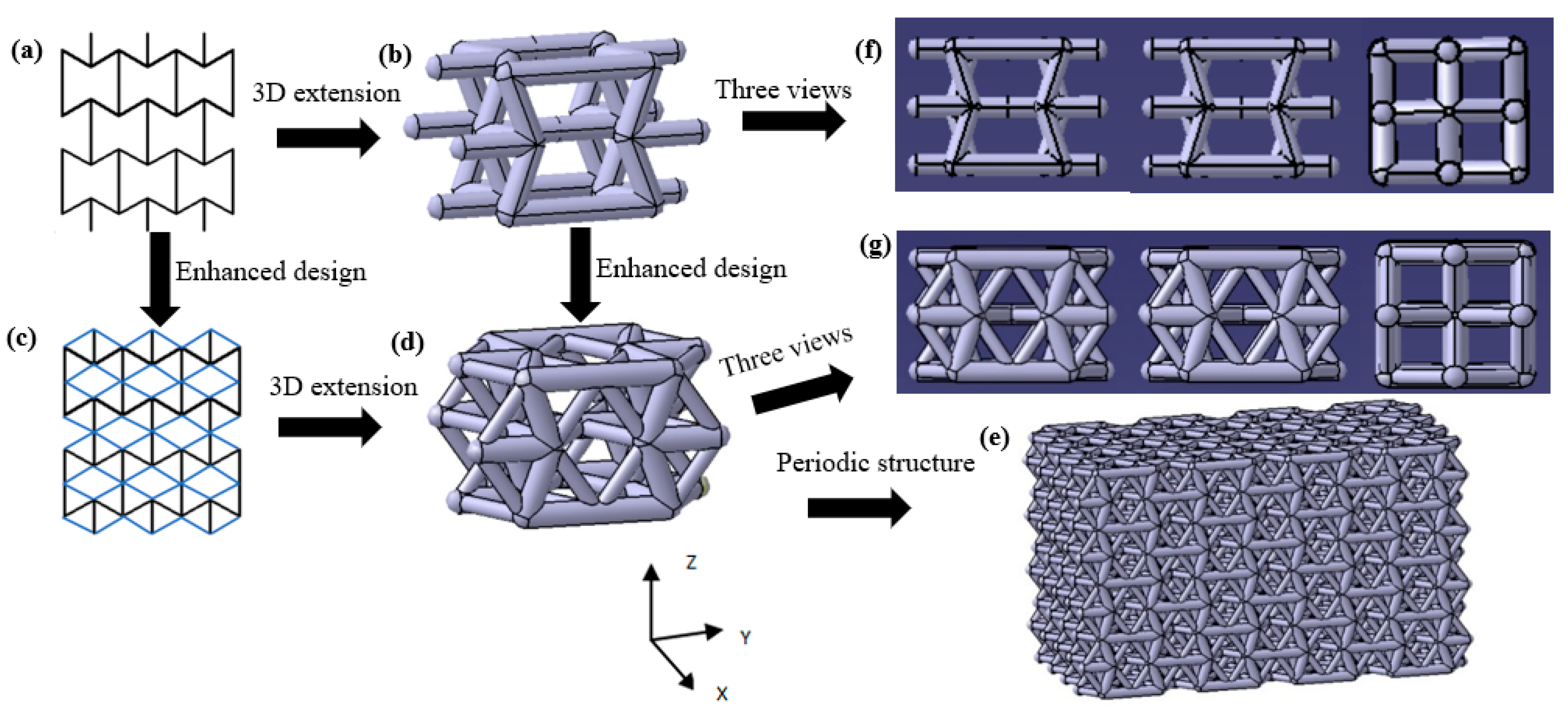
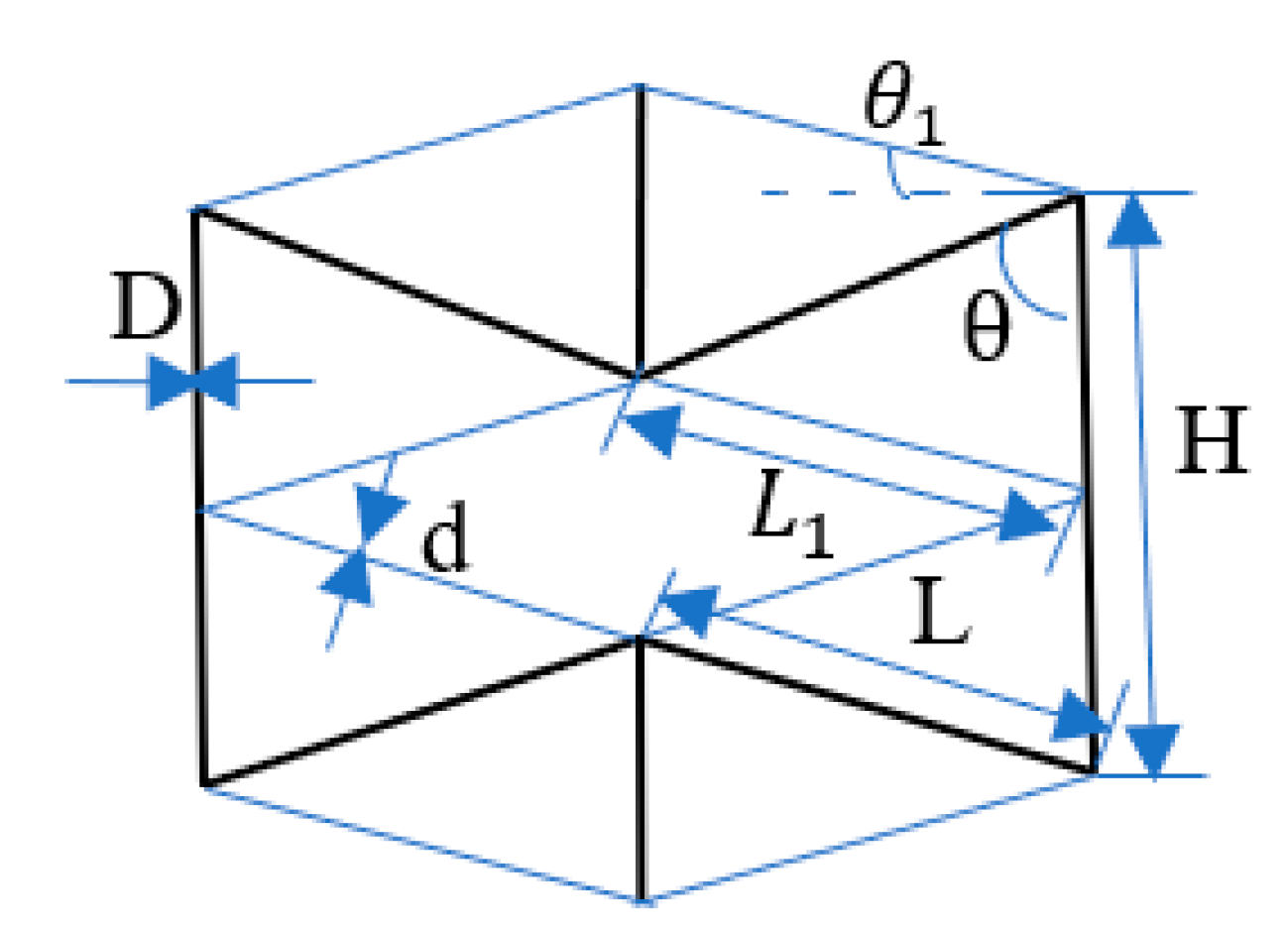

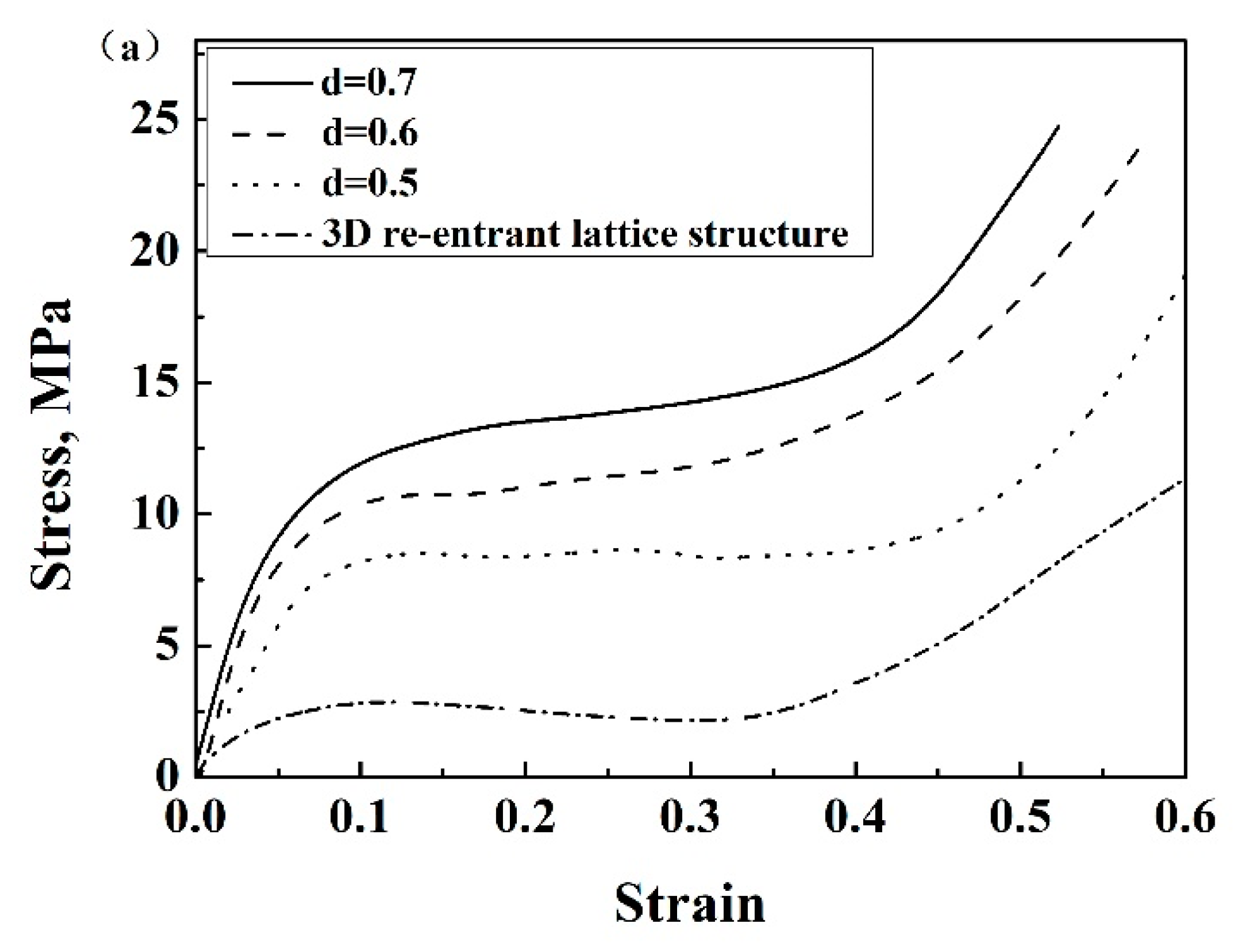
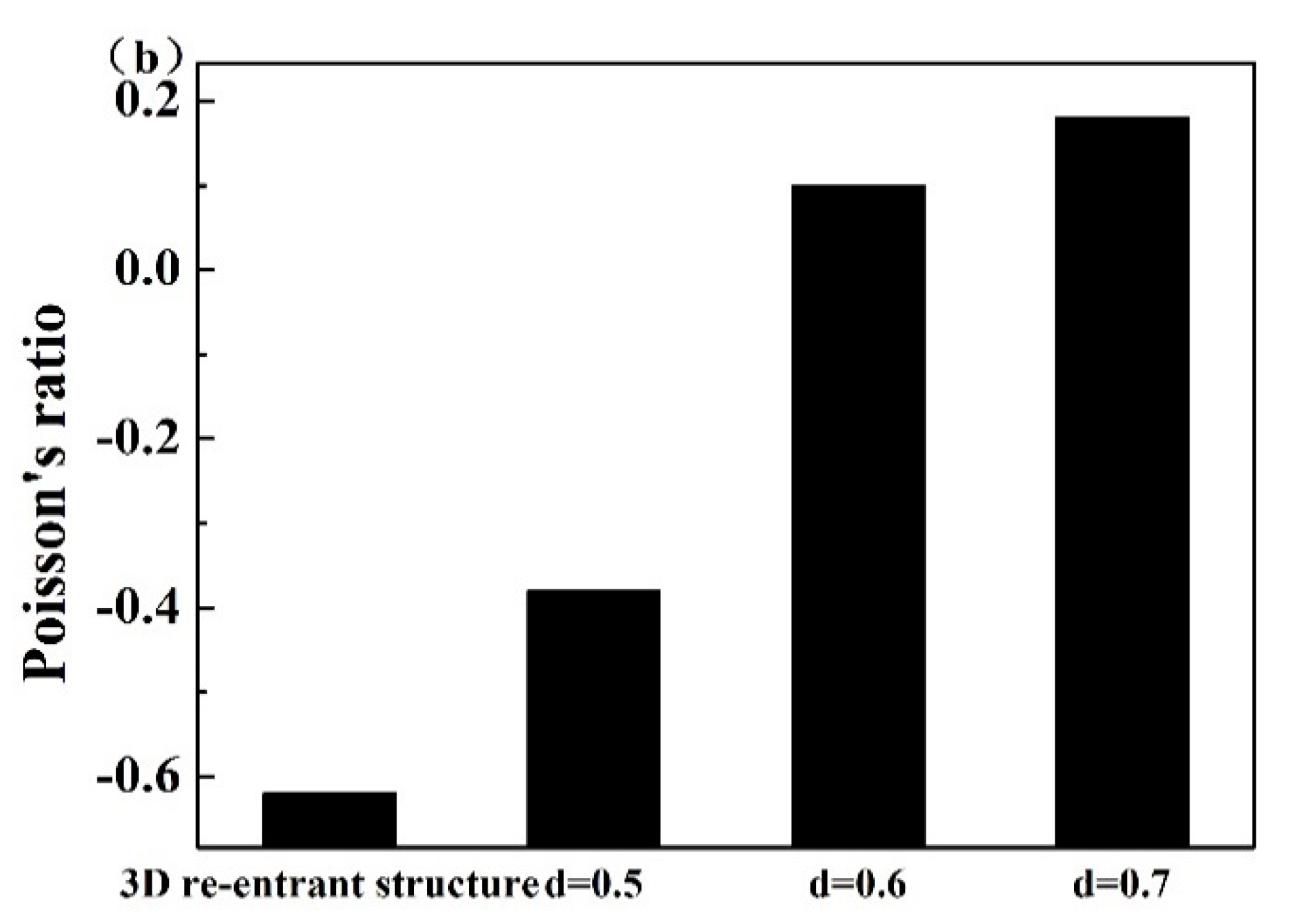

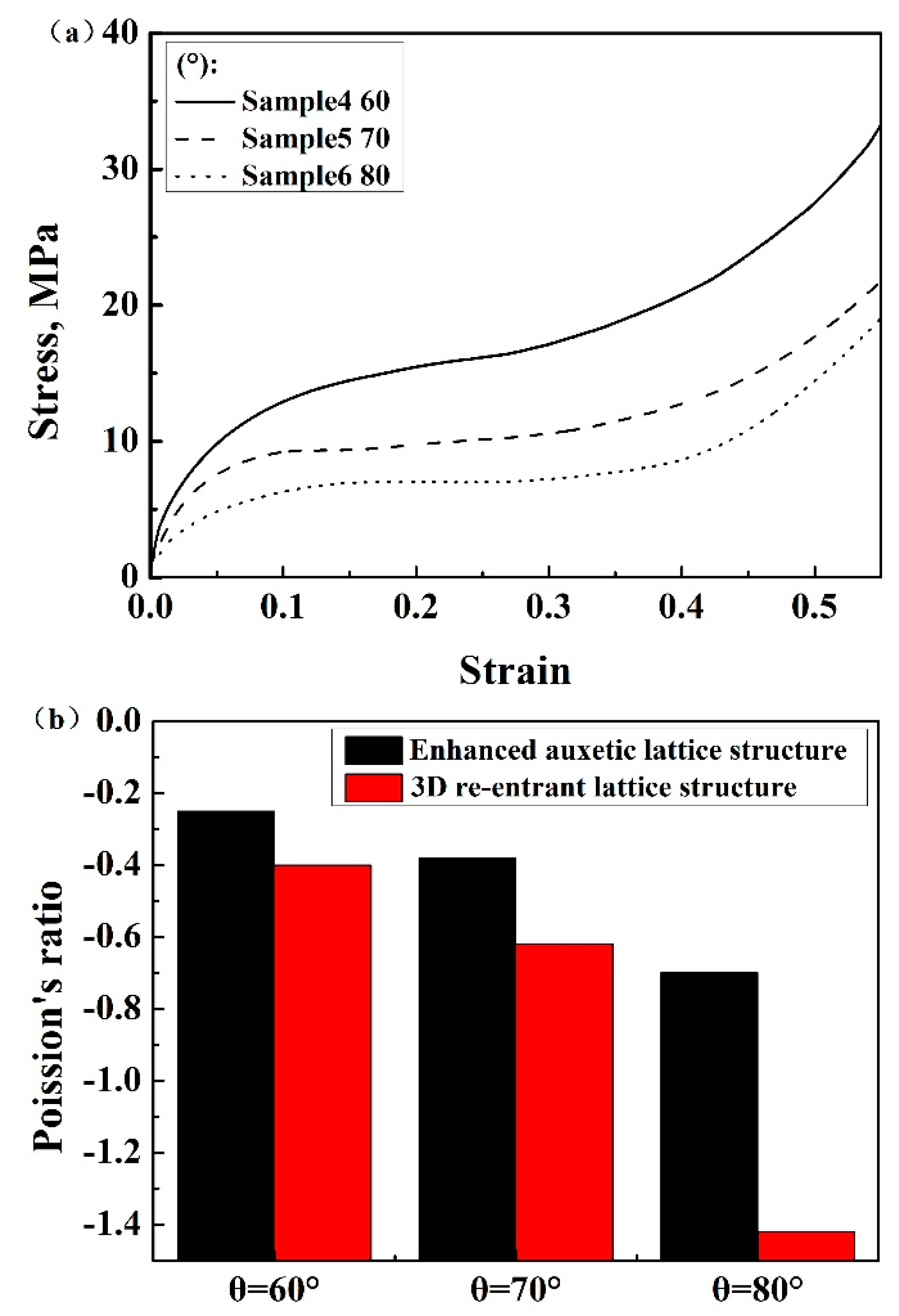
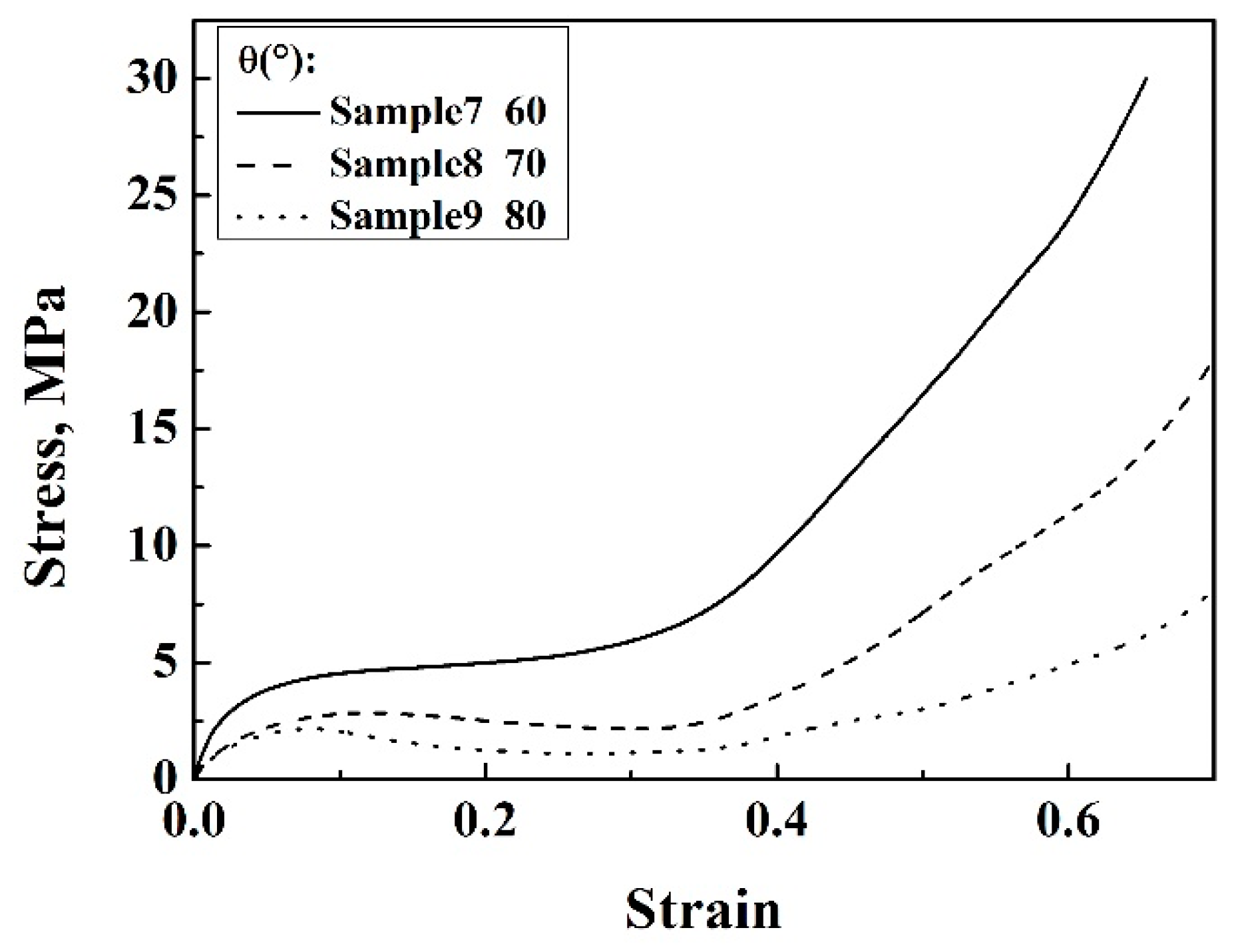
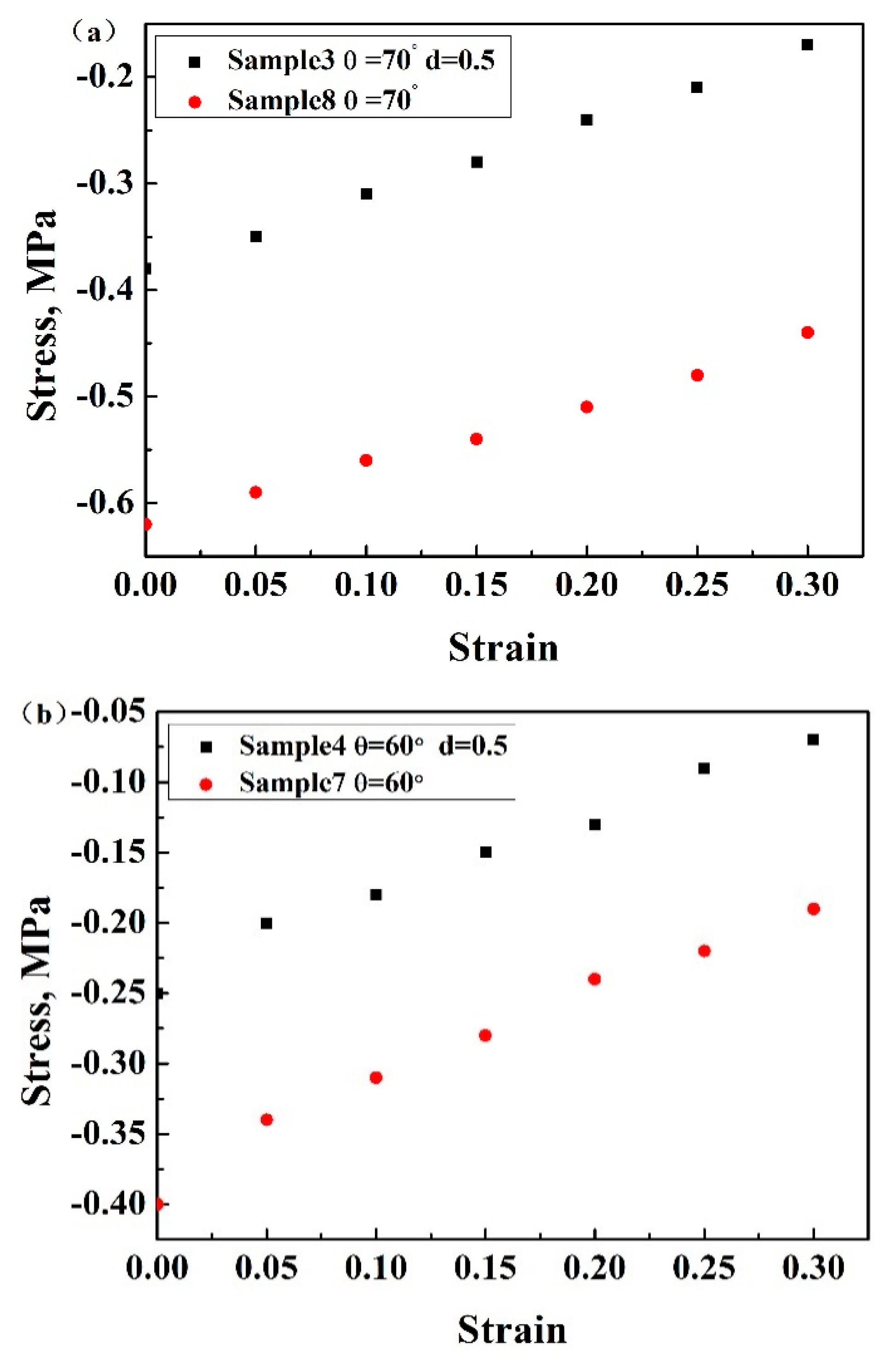
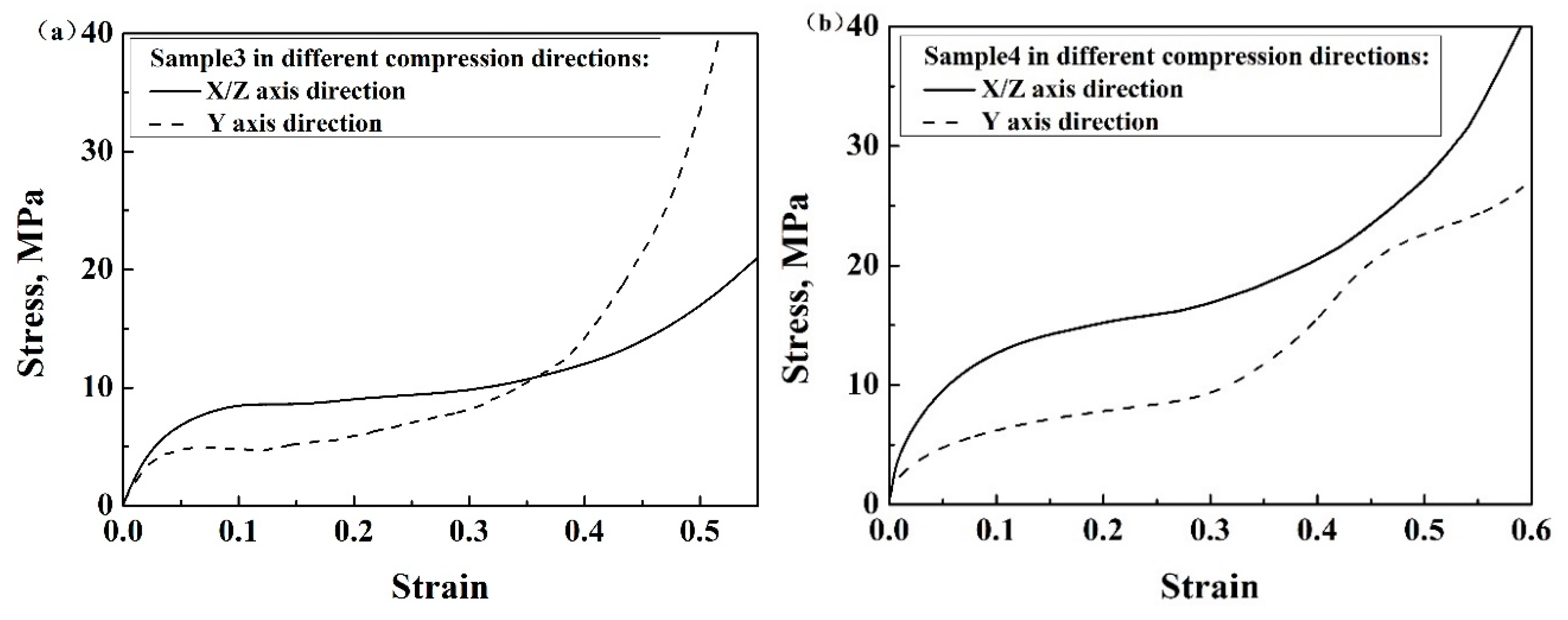

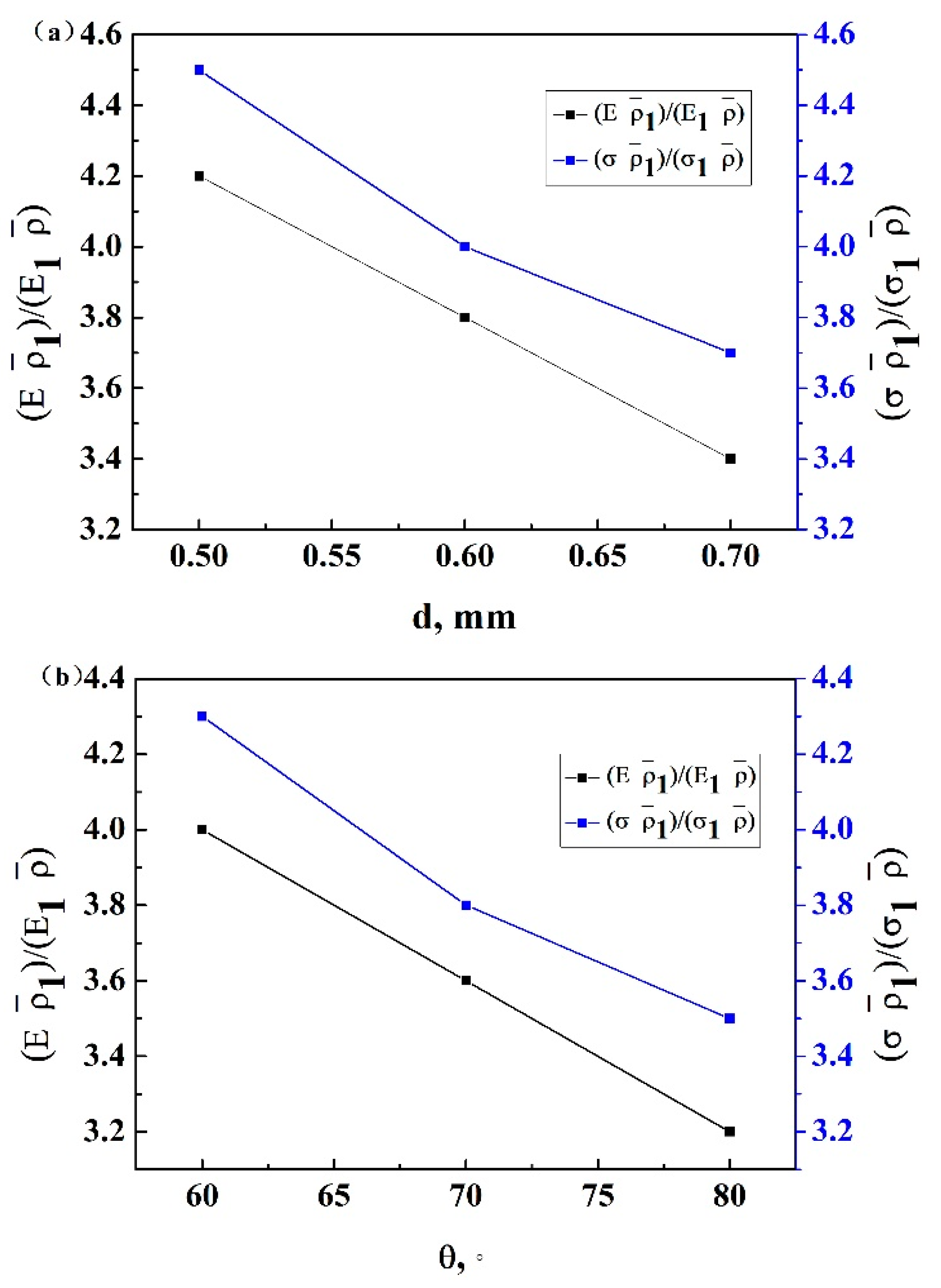
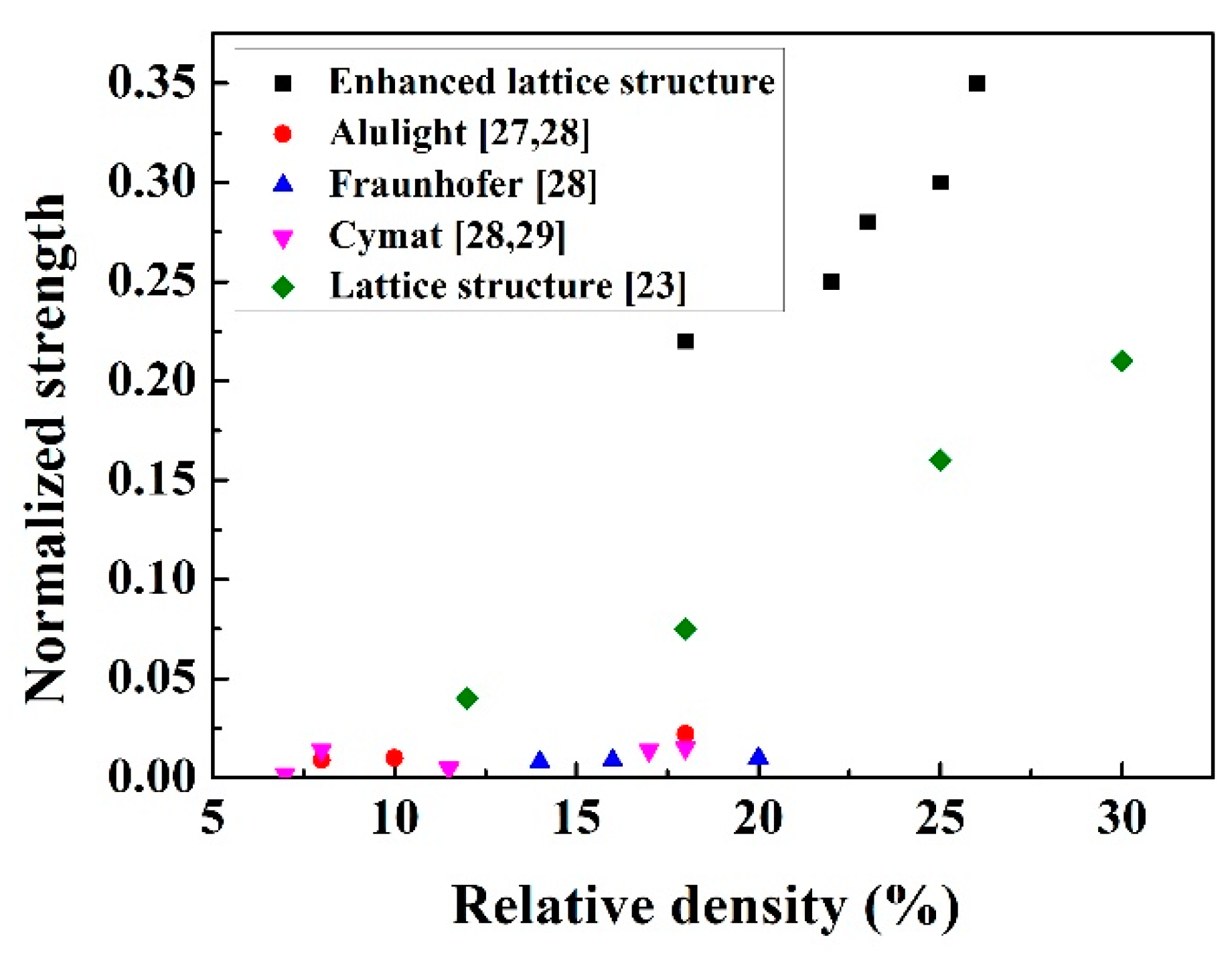
| Sample | H (mm) | L (mm) | θ (°) | D (mm) | d (mm) | Relative Density | |
|---|---|---|---|---|---|---|---|
| 1 | 7.0 | 3.5 | 70 | 1.4 | 0.7 | 0.27 | 0.25 |
| 2 | 0.6 | 0.25 | 0.23 | ||||
| 3 | 0.5 | 0.23 | 0.22 | ||||
| 4 | 7.0 | 3.5 | 60 | 1.4 | 0.5 | 0.28 | 0.26 |
| 5 | 70 | 0.25 | 0.22 | ||||
| 6 | 80 | 0.19 | 0.18 | ||||
| Sample | H (mm) | L (mm) | θ (°) | D (mm) | Relative Density | |
|---|---|---|---|---|---|---|
| 7 | 7.0 | 3.5 | 60 | 1.4 | 0.24 | 0.24 |
| 8 | 70 | 0.20 | 0.20 | |||
| 9 | 80 | 0.16 | 0.15 | |||
© 2020 by the authors. Licensee MDPI, Basel, Switzerland. This article is an open access article distributed under the terms and conditions of the Creative Commons Attribution (CC BY) license (http://creativecommons.org/licenses/by/4.0/).
Share and Cite
Xue, Y.; Gao, P.; Zhou, L.; Han, F. An Enhanced Three-Dimensional Auxetic Lattice Structure with Improved Property. Materials 2020, 13, 1008. https://doi.org/10.3390/ma13041008
Xue Y, Gao P, Zhou L, Han F. An Enhanced Three-Dimensional Auxetic Lattice Structure with Improved Property. Materials. 2020; 13(4):1008. https://doi.org/10.3390/ma13041008
Chicago/Turabian StyleXue, Yingying, Peixin Gao, Li Zhou, and Fusheng Han. 2020. "An Enhanced Three-Dimensional Auxetic Lattice Structure with Improved Property" Materials 13, no. 4: 1008. https://doi.org/10.3390/ma13041008
APA StyleXue, Y., Gao, P., Zhou, L., & Han, F. (2020). An Enhanced Three-Dimensional Auxetic Lattice Structure with Improved Property. Materials, 13(4), 1008. https://doi.org/10.3390/ma13041008





